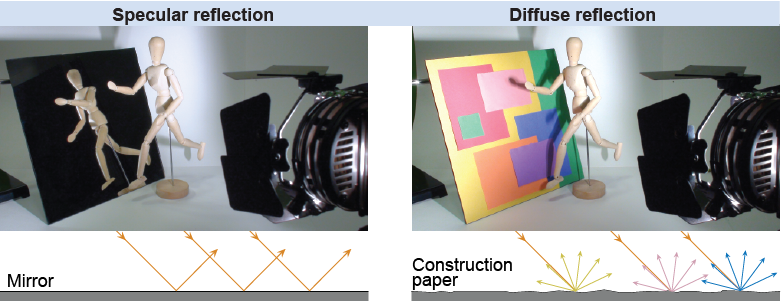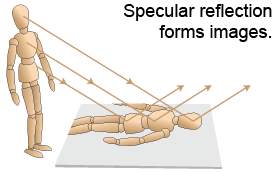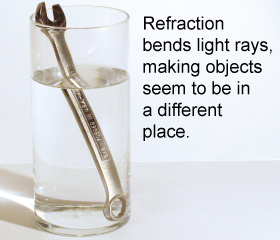|

|
Reflection occurs when light strikes a surface and some or all of the light “bounces” back. The diagram above illustrates two types of reflection. When light is reflected from a mirror you don’t see the mirror itself. Instead, you see the reflected image of the mannikin. When light is reflected from the painted board you see the surface of the board itself. 
|
 A mirror or shiny metal surface creates specular reflection. Specular reflection forms images because each ray that falls on the surface results in a single reflected ray at the same angle. You see an image because multiple light rays striking a mirror retain their original angles with respect to each other after reflection.
A mirror or shiny metal surface creates specular reflection. Specular reflection forms images because each ray that falls on the surface results in a single reflected ray at the same angle. You see an image because multiple light rays striking a mirror retain their original angles with respect to each other after reflection. 
|
 When light strikes a surface that is not shiny, such as a wall or a page in a book, the reflection is diffuse. In diffuse reflection, each light ray is absorbed and re-emitted (scattered) in a random direction. The scattered light rays come from the surface itself and that explains why you can see the color and texture of a diffuse reflecting surface.
When light strikes a surface that is not shiny, such as a wall or a page in a book, the reflection is diffuse. In diffuse reflection, each light ray is absorbed and re-emitted (scattered) in a random direction. The scattered light rays come from the surface itself and that explains why you can see the color and texture of a diffuse reflecting surface. 
|
 Light rays may bend when they cross a boundary between different materials. The bending of light rays by surfaces is called refraction. Refraction is why the wrench in the photograph appears to “break” at the water’s edge. It’s not really broken; the light refracting through the water causes the lower image of the wrench to be offset slightly. Different materials, such as glass, water, or diamond, refract light by different amounts.
Light rays may bend when they cross a boundary between different materials. The bending of light rays by surfaces is called refraction. Refraction is why the wrench in the photograph appears to “break” at the water’s edge. It’s not really broken; the light refracting through the water causes the lower image of the wrench to be offset slightly. Different materials, such as glass, water, or diamond, refract light by different amounts. 
|
Why can no reflected image be seen on a surface that exhibits diffuse reflection? - Light does not reflect off the surface.
- Light travels too fast to be reflected.
- Light can be reflected in any direction.
- Light changes direction as it passes through.
 |
The correct answer is c, light can be reflected in any direction. Incoming light from an image does not stay together, so the only information the observer receives is the color of the surface. 
|

